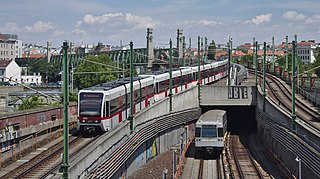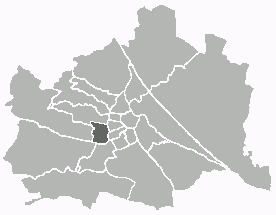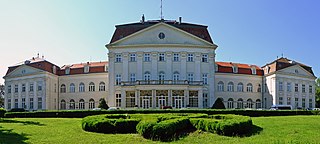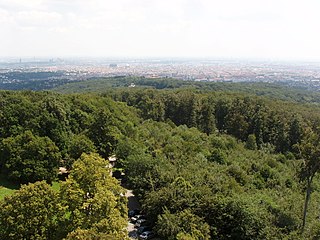
Baldur Benedikt von Schirach was a Nazi German politician who is best known for his role as the Nazi Party national youth leader and head of the Hitler Youth from 1931 to 1940. He later served as Gauleiter and Reichsstatthalter of Vienna. After World War II, he was convicted of crimes against humanity during the Nuremberg trials and sentenced to 20 years in prison.

The Vienna U-Bahn, where U-Bahn is an abbreviation of the German term Untergrundbahn, is a rapid transit system serving Vienna, Austria. With the September 2017 opening of the 4.6 kilometers (2.9 mi), five-station extension of the U1 line, the five-line U-Bahn network consists of 83.1 kilometers (51.6 mi) of route, serving 109 stations. It is the backbone of one of the best performing public transport systems worldwide according to UITP in June 2009. More than 1.3 million passengers rode the Vienna U-Bahn every day in 2009, and 567.6 million passengers used the U-Bahn in 2011, which declined to 428.8 million passengers in 2013. The network is undergoing expansion and rolling stock renewal. Since 1969, 200 million euros have been invested annually in the extension of the Vienna U-Bahn.

Flak towers were large, above-ground, anti-aircraft gun blockhouse towers constructed by Nazi Germany. There were 8 flak tower complexes in the cities of Berlin (3), Hamburg (2), and Vienna (3) from 1940 onwards. Other cities that used flak towers included Stuttgart and Frankfurt. Smaller single-purpose flak towers were built at key outlying German strongpoints, such as at Angers in France, Helgoland in Germany.

Judenplatz is a town square in Vienna's Innere Stadt that was the center of Jewish life and the Viennese Jewish Community in the Middle Ages. It is located in the immediate proximity of Am Hof square, Schulhof, and Wipplingerstraße. It exemplifies the long and eventful history of the city and the Jewish community focused on this place. Archaeological excavations of the medieval synagogue are viewable underground by way of the museum on the square, Misrachi-Haus. Two sculptural works, a carved relief and several inscribed texts are located around the square that all have subject matter relating to Jewish history. One of these sculptures is a statue of Gotthold Ephraim Lessing. The other is a memorial to Austrian Holocaust Victims, a project based on an idea of Simon Wiesenthal and unveiled in 2000. Created by British artist Rachel Whiteread, the memorial is a reinforced concrete cube resembling a library with its volumes turned inside out.

Ottakring is the 16th District in the city of Vienna, Austria. It is located west of the central districts, north of Penzing and south of Hernals. Ottakring has some heavily populated urban areas with many residential buildings. It was formed from the independent villages of Ottakring and Neulerchenfeld in 1892.

Rudolfsheim-Fünfhaus is the 15th municipal District of Vienna, Austria. It is in central Vienna, west of Innere Stadt.

The Raven Rock Mountain Complex (RRMC), also known as Site R, is a U.S. military installation with an underground nuclear bunker near Blue Ridge Summit, Pennsylvania, at Raven Rock Mountain that has been called an "underground Pentagon". The bunker has emergency operations centers for the United States Army, Navy, Air Force and Marine Corps. Along with Mount Weather Emergency Operations Center in Virginia and the Cheyenne Mountain Complex in Colorado, it formed the core bunker complexes for the US continuity of government plan during the Cold War to survive a nuclear attack.

Vienna City Hall is the seat of local government of Vienna, located on Rathausplatz in the Innere Stadt district. Constructed from 1872 to 1883 in a Neo-Gothic style according to plans designed by Friedrich von Schmidt, it houses the office of the Mayor of Vienna as well as the chambers of the city council and Vienna Landtag diet. For a brief period between 1892-1894, the Vienna City Hall was the world's tallest building, until it was eclipsed by Milwaukee City Hall.

The Arsenal is a former military complex of buildings in the south-east of Vienna in the third district.

Austrian air defence is the air defense system that protects the nation of Austria. It integrates civilian and military radar systems under the authority of the Austrian Air Force.

Donau City, or Vienna DC, is a new part of Vienna's 22nd District Donaustadt, next to both the Reichsbrücke and the left bank of the Danube's 21.1 km new channel, Neue Donau.

Wilhelminenberg Castle is a former palace dating from the early 20th century, which is now a four-star hotel, restaurant and conference facility. It is situated on the eastern slopes of the Gallitzinberg, in the Wienerwald western parts of the Austrian capital, Vienna.

Lokomotivfabrik Floridsdorf was an Austrian locomotive works founded on 6 September 1869 that achieved a pre-eminent place amongst European locomotive builders thanks to the quality and diversity of its designs.

The Gallitzinberg is a forested hill in the West of Austria's capital, Vienna. While it is relatively inconspicuous in the broader context of the Northeastern end of the Wienerwald mountain range, it is nevertheless remarkable because of its multifaceted history, and because it functions as an important recreational area in the Western uphill part of the densely populated Ottakring district.

Trams in Vienna are a vital part of the public transport system in Vienna, capital city of Austria. In operation since 1865, with the completion of a 2 km route to industrial estates near Simmering, it reached its maximum extent of 292 km in 1942. In February 2015, it was the fifth largest tram network in the world, at about 176.9 kilometres (109.9 mi) in total length and 1,071 stations.

Wien Mitte is a rail and U-Bahn station in Vienna, close to the city centre. It is the city terminus of Vienna's City Airport Train (CAT), which provides non-stop service to Vienna International Airport. The station is a major hub for S-Bahn suburban trains, with little service by Inter-City trains. The station is connected to the Mitte / Landstraße U-Bahn station.

The Party of Labour of Austria is a communist party in Austria. PdA was founded on 12 October 2013 by the Communist Initiative, a Marxist-Leninist breakaway faction of the Communist Party of Austria (KPÖ), who were dissatisfied with the party's ideological orientation.

The First Vienna Mountain Spring Pipeline is a major part of Vienna's water supply and was the first source of safe drinking water for that city. The 95 km long line was opened on 24 October 1873, after four years of construction. Today, it delivers 62 million cubic meters of water per year. The water comes from high springs in the Rax and Schneeberg areas in Southern Lower Austria and Styria.

The Vienna Transport Museum "Remise", formerly the Viennese Tram Museum, is a museum in Vienna, Austria, run by Wiener Linien and dedicated to public transport. It is the largest tram museum dedicated to the public transit vehicles of a single city.

Steinhof in Vienna, Austria, is an old name for an area of Vienna that today contains the Otto-Wagner-Spital as well as its church Kirche am Steinhof and the surrounding parks of the Steinhofgründe, which were opened in 1907. Historically the area is also linked to the Am Spiegelgrund clinic, where 789 patients, mostly children, were murdered during World War II under the child euthanasia in Nazi Germany from 1940 to 1945.






















